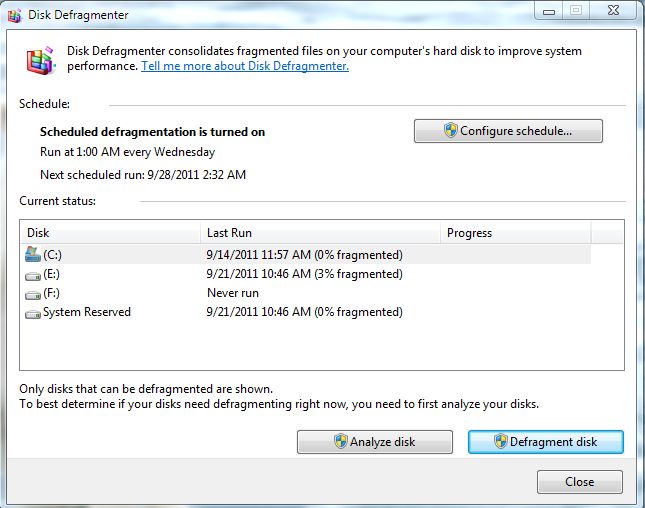Defragmenting your computer’s hard drive should be a regular part of your maintenance routine. Is it? If it’s not, and if you don’t know what the heck defragging is, read on.
If you’re like me, but who is, you probably download pictures, music and software quite a bit. Once you’re done with whatever it is you’ve downloaded, then you delete it. Right? The more you do this, the more your hard drive gets ‘fragmented’. Let’s consider what Windows tries to do when you’re using your computer. Like any other stressed worker, Windows feels the need to hurry up and get things done. I know, sometimes it doesn’t seem that way but Windows does the best it can do.
When Windows is putting your stuff away, that is putting your files where it thinks it has room, sometimes it just throws everything everywhere. This is similar to someone getting ready for an evening out. Clothes fly here, shoes fly there and, at the end of the preparations, the person looks great but the room is a disaster. That’s what your drive is like after a few weeks or months of adding and deleting files.
Windows knows where everything is, it just takes longer to find things because of the mish-mash on the drive surface. It’s the same thing as the person’s room in the example above. Everything is still there, nothing has disappeared but things take time to find.
Defragging is simply a cleaning up process that puts all of the ‘fragments’ of the files in order, more or less. Windows sorts out the bits of files, puts them back in order and creates an empty space, known as contiguous space. Basically this is like a landing zone where Windows can start to throw stuff again when the defragging is finished. If you haven’t used a defragmenter lately or, god forbid, you have never used one before, make sure you get at it. Here’s how:
1. Before you go to bed or before you head out somewhere and know that you won’t be using your computer, turn off everything except the computer itself. Of course, leave your anti-virus on but turn off things that run in the background: chat engines, software updates and things like that.
2. Go to Start, All Programs, Accessories then System Tools and choose “Disk Defragmenter”. You’ll see a menu like this:

3. Click on your main drive, almost always (C:) and click on ‘Analyze disk’. Windows will then take a peek at your hard drive and see how messy it is.
4. If the drive is anything above 5% defragmented, I would suggest degragging it. I just did this on my two year old netbook that I use infrequently for file downloads. After two years of more or less daily use, the drive was 14% defragmented. After defragging, the computer was noticeably faster.
5. Once the analysis is finished, click ‘Defragment disk’ if it is sufficiently fragmented. Right now, the hard drive on this computer is 8% defragmented. However, this drive is a 2 terabyte drive and, while I probably need to defrag it, I will wait until I go to bed tonight. The larger your hard drive, the longer it takes to defrag. I can see the defragging on this drive taking several hours or more.
6. Once the defragging is done, reboot your computer and, hopefully, you’ll notice a difference in speed. There are other ways to speed up your computer so stay tuned to this spot for more help.
TIP : If you have one of the new SSD drives, you don’t have to defrag it. In fact, Windows should turn off automatic defragging as soon as it has sensed the type of drive you have. Automatic defragging can be set in your Task Schedule but, hey, who remembers to set that up?
Thanks for reading. Questions are welcome. Follow me on Twitter (top right of this page).
